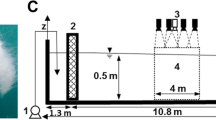Abstract
THROUGH the kindness of Dr. K. R. S. Morris, Gold Coast, I received a living specimen of Gymnarchus niloticus, a fish which occurs in the rivers of West Africa and in the Nile. Observation of this fish in an aquarium has revealed two striking features: (i) a mode of locomotion through waves passing over the extended dorsal fin and executed forwards and backwards with equal ease; (ii) a marked ability of the fish to avoid obstacles while swimming backwards. The hind end and particularly the finger-like tail are known to contain tissues corresponding to an electric organ; it seemed of interest to consider whether this organ may enable the animal to detect objects in the vicinity of its body.
Similar content being viewed by others
References
Regnart, H. C., J. Mar. Biol. Assoc., 17, 415 (1930–31).
Author information
Authors and Affiliations
Rights and permissions
About this article
Cite this article
LISSMANN, H. Continuous Electrical Signals from the Tail of a Fish, Gymnarchus niloticus Cuv.. Nature 167, 201–202 (1951). https://doi.org/10.1038/167201a0
Issue Date:
DOI: https://doi.org/10.1038/167201a0
- Springer Nature Limited
This article is cited by
-
Model organisms and systems in neuroethology: one hundred years of history and a look into the future
Journal of Comparative Physiology A (2024)
-
Long-range and high-precision localization method for underwater bionic positioning system based on joint active–passive electrolocation
Scientific Reports (2023)
-
Normoxia exposure reduces hemoglobin concentration and gill size in a hypoxia-tolerant tropical freshwater fish
Environmental Biology of Fishes (2023)
-
On mating and function of associated electric pulses in Clarias macrocephalus (Günther 1864): probing an old puzzle, first posed by Charles Darwin
Environmental Biology of Fishes (2020)
-
Passive electroreception in aquatic mammals
Journal of Comparative Physiology A (2013)





